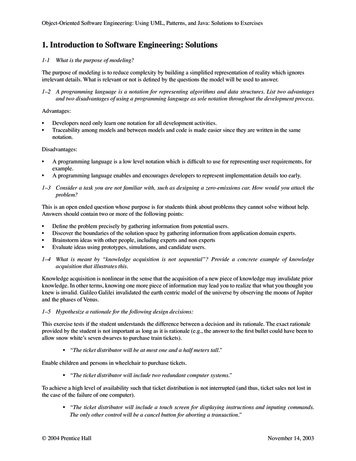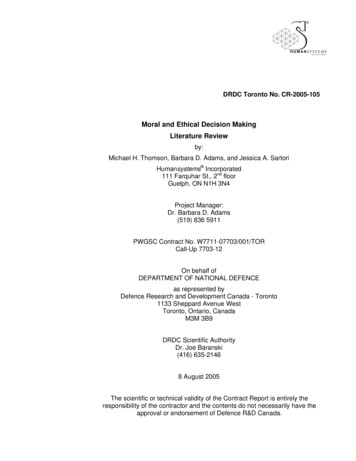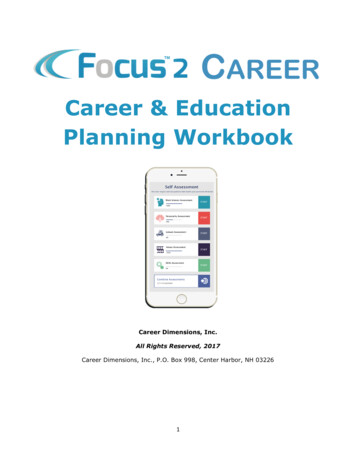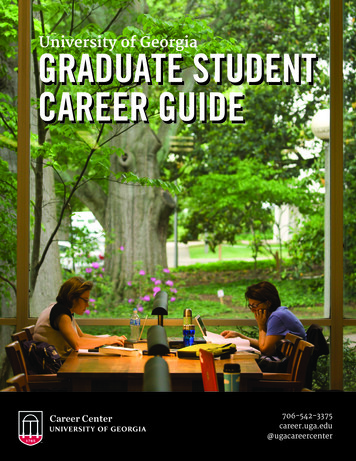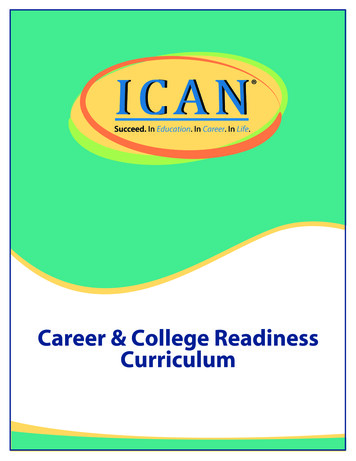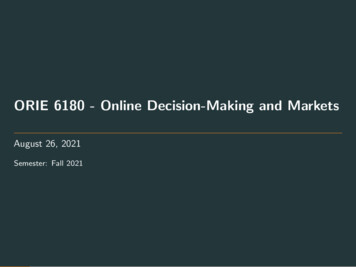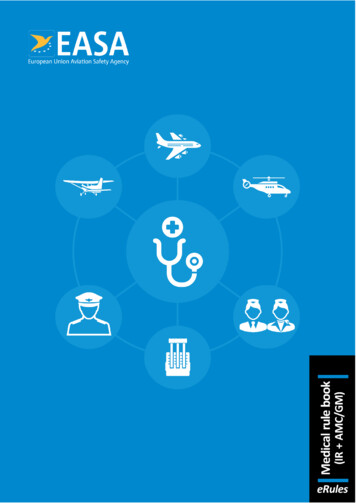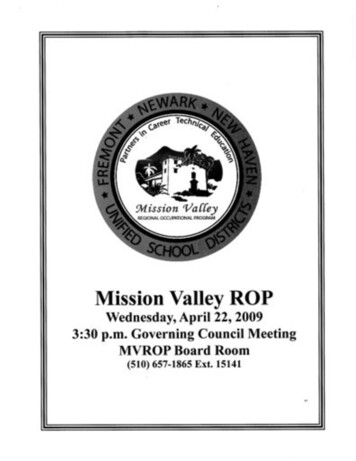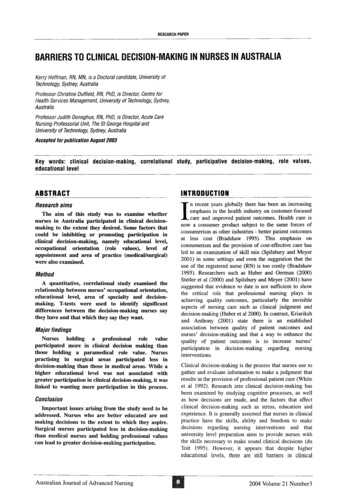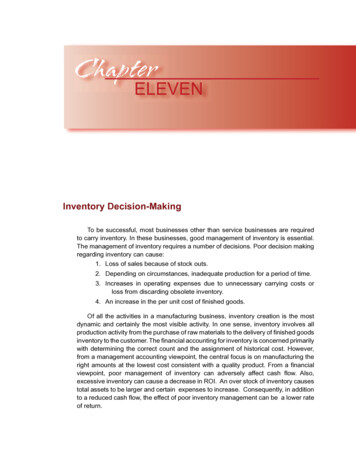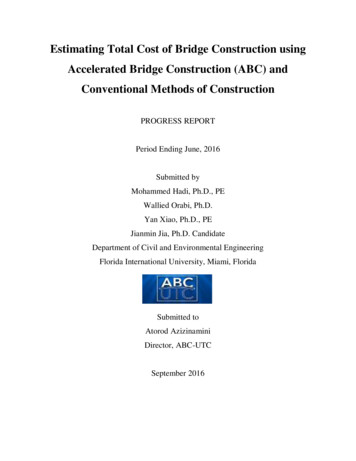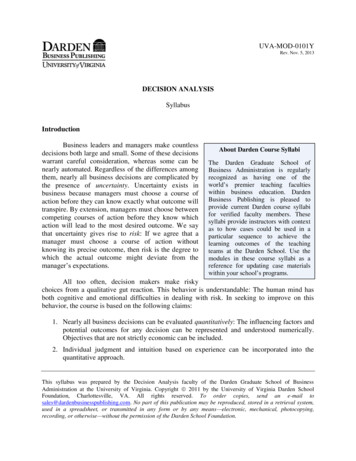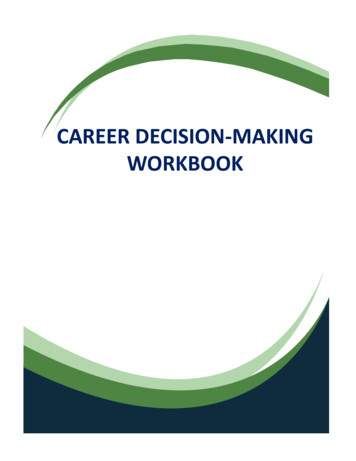
Transcription
CAREER DECISION-MAKINGWORKBOOK
The Canadian Career Development Foundation20152
If you are unsure what you want to doafter school or throughout yourcareer,this guide is for you.It has three sections:1. KNOW YOURSELFSection 1 will help you define your personal profile (values, personalcharacteristics, abilities, and interests) and identify possible occupationsthat will fit your profile.2. KNOW THE LABOUR MARKETSection 2 will show you how to research possible occupations using theInternet, networking and interviews with people.3. PUT IT ALL TOGETHERSection 3 will help you to establish a career goal and develop an actionplan to reach that goal.3
You may not need to do all sections of this guide. Each section includesworksheets that will support your career exploration. It is up to you to decidewhich worksheets you want to use.If you want to find a specific activity or work sheet as you’re working through theguide, you can use the Page Finder on pages 73-74 (the last pages of this guide). Itprovides a listing of all the content of the manual and the corresponding pagenumbers.In addition to the guide, you will need access to a computer not only to accessself-exploration quizzes in recommended websites, but also to researchoccupations that may fit your personal profile.If you need any help with computer use or additional resources, visit your locallibrary, guidance office, post-secondary Career Centre or provincial/territorialemployment service.Researching occupations may seemoverwhelming. This guide will take youstep-by-step to get clear about what youwant and how to get there.4
CAREER DECISION-MAKING GUIDESECTION 11. KNOW YOURSELFThis section will help you look at 2 things:– Yourself: What are my values? What are my personal characteristics? What are my abilities? What are my interests?– Occupations: What occupations interest me and might be right for me?5
1. Know YourselfIs this section really for you?This section will help you create your personal profile to ensure that your chosenoccupation is a good “fit” for you.Here’s a quick check-in to see if this section is relevant to you:1. I am clear about the values that are important for me ------------------------------ ------------------------------ NoSort ofYes2. I know my personal characteristics ------------------------------ ------------------------------ NoSort ofYes3. I am clear about my interests ------------------------------ ------------------------------ NoSort ofYes4. I can name occupations that interest me and are a good fit ------------------------------ ------------------------------ NoSort ofYesIf you did NOT answer a full “YES” to one or more of these questions,then this section could be useful to you.If all your answers were a full “YES”, you can go directly toSECTION 2 (Know the Labour Market) on page 31.6
a. KNOW YOURSELF Values Worksheet Personal Characteristics Worksheet Abilities Worksheet Interests Worksheet Personal Profileb. LOOK AT OCCUPATIONS Occupations of Interestc. ACCESS RESOURCES Career Exploration Websites Sector Matrices71. Know YourselfMost of us need to make career choices more than once in our life. To do it well,you need to have a good idea about who you are and what you like. In this sectionyou will have the chance to think about things you may not have thought aboutbefore. This section includes worksheets and resources that will help you:
1. Know YourselfIn addition to using this guide, you can visit websites with quizzes that will helpyou identify your values, personal characteristics, abilities and interests andprovide lists of occupations that match your answers. Here are fourrecommended sites to get started: www.careercruising.com – you’ll need an access code to sign in. If youdon’t already have one, visit your local library, guidance office, postsecondary Career Centre or provincial/territorial employment service. ForStep 1, do the Career Quizzes and get matched up to occupations. Print theoccupations and results and keep them in your folder. www.jobbank.gc.ca – when the “Home Page” opens choose “CareerNavigator”, create an account, and do any quizzes you like. They will giveyou a list of occupations or fields of work to explore. Print each quiz you doand keep it in your folder. http://careerplanning.about.com/od/careertests/ - when the “Home Page”opens scroll down the page to “Browse Topics” and select “SelfAssessment”. When the Self-Assessment page opens select “Career Tests”where you will be able to take free career tests. They will give you a list ofoccupations or fields of work to explore. Print the occupations and resultsand keep them in your folder. www.setyourownpace.org – When the home page opens select “Enter”.Click on the Icon to the left of “Step 1: Identify Interests” to find some selfinterest activities and a short video called “How to Choose the RightCareer”. Print the lists you create and keep them in your folder. http://www.manitobacareerdevelopment.ca – Click on “Get Started” andchoose “Interests, Values, Strengths and Skills”. You’ll find all kinds ofquizzes and self-assessments that you can complete.You are ready to start building your Personal Profile. The first activity you willwork on is “My Values Worksheet”.TIP: Don’t forget to print off your results and the suggestedoccupations to keep in your folder.8
Most people are happiest doing work that allows them to live according to their values.Here are some examples of values. Start by circling any that apply to you. If some importantvalues are missing, write them in the blank dependenceHumourPromoting PeaceBeautyIntegrityHuman RelationsCompetitionJusticeRespect of self and othersPhysical comfortFreedom (to act and express views)Personal achievementContributing to societyLeisure/Having funHealthCreativityLoyaltyPersonal satisfactionCulture/LanguageModestyCareer securityReaching my full Social statusCooperationOpennessWorkThe ctualityFamilyPowerIf you were allowed to have only 3, which ones would you keep? Put these 3 values on yourPersonal Profile Worksheet on page 13:91. Know YourselfValues Worksheet
1. Know YourselfPersonal Characteristics WorksheetYou have specific characteristics that make you unique – and especially well-suited for certainjobs.Here are some examples of personal characteristics. Circle any that describe you. If someimportant characteristics are missing, write them in the blank boxes.PreciseCuriousIntuitiveRealisticDown to erceptiveSpontaneousConfidentGenerousA rablePracticalCriticalTactfulIf you were allowed to have only 3, which ones would you keep? Put these 3 on your PersonalProfile Worksheet on page 13.10
You can develop abilities at home, school and work and in your leisure and volunteer activities.You can do some things better than others. It is important to recognize what you do well andbring to a job.Here are some examples of abilities. Circle any that you have. If some important abilities aremissing, write them in the blank boxes.Helping others (listening,Giving instructions, informationOperating heavy equipmentLearning new thingsNegotiatingPublic speakingWorking with othersDeveloping strategiesMaking decisionsAssembling thingsWriting (grammar, spelling)Preparing text, documentsSingingExplaining or teachingPredicting consequencesClassifying objects, documentsResearchingSellingUnderstanding/Speaking otherlanguagesPlanningRepairing (computers, things)Composing (text, music)ImprovisingSummarizingDrivingManual labourProblem-solvingEditing/Correcting textManaging stressWorking with numbersCreating/InventingEstablishing systems/processesUsing camera equipmentWorking independentlyInterviewing peopleUsing different softwareConsulting with peoplePlaying a musical instrumentUsing laboratory apparatusDrawing/ReproductionReading comprehensionUsing tools (saw, hammer)Leading a group discussionNavigating onlineTraining animalsGiving good adviceAnalyzing (text, data)Making lists (of things, priorities)understanding)Comparing (things, data)If you were allowed to have only 3, which ones would you keep? Put these 3 abilities on yourPersonal Profile Worksheet on page 13.111. Know YourselfAbilities Worksheet
1. Know YourselfInterest WorksheetThe things you like to do can often give you an ideaof the kind of job that you would be good at. Doyou know the field of work you would enjoy most?Here’s a quiz that can help you sort out yourinterests. Respond “Yes” or “No” to the statements.After you do this Quiz, go back and circle your top3 interests and write them on your PersonalProfile Worksheet on page 13:Yes No 1. I’d rather make something thanTo find out areas of work that may interest you,compare your answers to the numbers in thefollowing groups.2.3.Numbers 1, 5, 9, 12, 15, 16, 18, 23.If you have responded “Yes” to most of thesenumbers, you are probably a hands-on “THINGS”person. You like to work with tools and machines,make things with your hands, fix and maintainequipment, or find out how things work. Jobs youmight like are found in engineering, productmanufacturing, construction, repair and servicing,transportation, trades and technology.4.5.6.7.8.9.Numbers 2, 4, 7, 10, 13, 19, 21, 24.If you have responded “Yes” to most of thesenumbers, you are probably an “INFORMATION”person. You like to express yourself throughwriting, music or art, perform experiments orresearch, solve puzzles and problems, or study andread. Jobs dealing with information are found inarts and entertainment, business and finance,scientific research, sales and services, tourism, lawand government.Numbers 3, 6, 8, 11, 14, 17, 20, 22.If you have responded “Yes” to most of thesenumbers, you are probably a “PEOPLE” person.You like to care for and help others, encouragepeople, work as part of a team, and lead andsupervise others. Jobs dealing with people arefound in health care, education and training, socialwork and counselling, and religion.If you responded “Yes” to numbers from eachgroup, it could indicate that you don’t have a clearpreference for a specific type of job. You may besuited for a job that combines a number of 21.22.23.24.read a book.I enjoy problem-solving games andworking at puzzles.I like helping others when they needit.I enjoy reading and learning aboutnew topics.I like working with my hands.I like being the leader in a group ofpeople.I prefer to know all the facts before Itackle a problem.I like to take care of other people.I enjoy designing, inventing orcreating things.I enjoy expressing myself throughart, music, or writing.I would like a job where I can dealwith people all day.I like working with materials andequipment.I enjoy learning new facts and ideas.I find co-operating with otherpeople comes naturally to me.I like finding out how things work bytaking them apart.I would rather work with machinesand things than with people.I can usually persuade people to dothings my way.I enjoy building and repairing things.I enjoy the research part of myprojects.I like being with people.I enjoy thinking up different ideasand ways to do things.I like hearing other people’sopinions.I enjoy learning how to use differenttools.I find it easy to follow writteninstructions.
Now that you have transferred the results of the work you have done with the 4 worksheets,you can have a look at your personal profile. This profile will be very useful when you areresearching occupations. It will serve as a reference for choosing an occupation that fits you.My Top Values I value I value I value My Top Characteristics I am I am I am My Top Abilities I am really good at I am really good at I am really good at My Top Interests I really like I really like I really like 131. Know YourselfPersonal Profile Worksheet
1. Know YourselfOccupations of InterestAs you have a clearer idea of your values, personal characteristics, abilities and interests andyou took the time to look at your personal profile, you are now in a good position to startlooking at occupations that might suit your profile.To connect your profile to specific occupations, you can consult any of the following sources:1. www.careercruising.com – You’ll need an access code to sign in. If you don’t alreadyhave one, visit your local library, guidance office, post-secondary Career Centre orprovincial/territorial employment service. If you used it to complete self-assessmentquizzes and exercises, it will provide you with a list of occupations that match yourprofile. Print the occupations and results and keep them in your folder.2. www.jobbank.gc.ca – once you’ve used the “Career Navigator”, create an account, anddo the quizzes, it will give you a list of occupations or fields of work to explore. You canalso click on “Explore Careers” and you’ll find lists of occupations. You can find outabout local wages and outlooks, education programs and the skills/knowledge required.3. http://careerplanning.about.com/od/careertests/ - Once you have completed the FreeCareer Tests to help you identify your interests and work style, you will be given a list ofcareers that match.4. http://www.manitobacareerdevelopment.ca – Many of the quizzes in the “Get Started”section will link you with suggested occupations.5. http://www.youth.gc.ca/eng/home.shtml - On the left hand menu under “Life Events”select “Find a Job”. When the page opens look to the left hand menu again and select“Careers” under “Topics”. Select “Potential Fields of Work” from this page. You willfind a wide range of industries and occupations to choose from.6. You will find a list of occupations from the Sector Information Charts in the resources atthe end of this section. These are just a few examples of the range of jobs within a fewsectors. In addition, the New Brunswick Economic Growth Strategy ts/economic development/ecdev.html offers information on New Brunswick Industry Sectors.7. Any of the Career Exploration Websites listed at the end of this section (page 16).14
Now you are going to narrow your list of occupations using your knowledge of yourself andyour best judgment with the information you have. In the next section, you will research thesechosen occupations in more depth.To narrow your choices, start by choosing 10 occupations that interest you and could be amatch for your personal profile. Remember, nothing is perfect. You want to get as close aspossible to your profile given the information you have right now.Write down these 10 occupations:1.2.3.4.5.6.7.8.9.10.Now, cut down the list to the 4 occupations that you think would interest you the most. Writethem in the numbered spaces below.1.2.3.4.CONGRATULATIONS! YOU HAVE COMPLETED SECTION 1.You can now: take these 4 occupations to SECTION 2research them in more depthfind out what you would be doing, wages you might be making, the training you wouldneed, and prospects for work in the future.151. Know YourselfAs you look at occupations, keep a record of the ones that seem to be a good match for you.Don’t get discouraged by the size of the lists. Try to stay connected to yourself and yourpersonal profile. Be aware of your reactions to the occupations.
1. Know YourselfCareer Exploration WebsitesCareer Cruising (www.careercruising.ca):get an I.D. and password from the resourcecentre staff. It includes occupational information,career quizzes, information about educationalinstitutions and videos of working people.Skills Canada www.skillscanada.com):includes information regarding the manyskilled trades and technologies careers.The Canadian ApprenticeshipForum (www.caf-fca.org): find links toGovernment of Canada(www.jobbank.gc.ca): includes information onoccupations in Canada by occupational code,educational program or by wages and outlook orskills and knowledge.Monster.ca (www.monster.ca): providesaccess a wealth of job descriptions as well as selfassessment quizzes.Careers That Work(www.careersthatwork.ca) provides careerresources to help with career planning, jobsearch strategies and labour market information.Youth Employment Information(www.youth.gc.ca): shows how to plan yourcareer, learn about your interests and skills, andmuch more.Essential Skills shtml): find hundreds of Essential Skills profiles under“Access the Profiles”.16all Provincial/Territorial apprenticeshipbranches and key industry partners.Career ds/2010/12/Career Directions profiles.pdf ): provides detailedinformation on 186 occupations which donot require a university degree.Career Planning(http://careerplanning.about.com):includes career planning resources andtools to help you choose your career pathor make a career change.
Industries (sometimes called Sectors) in Canada have councils and websites withinformation about their industry.The Information Charts on the next pages show some industry job titles and whatlevel of skill you need for the job. The charts also indicate a possible career path.These are just a few examples, but they give you an idea of the wide range ofjobs in a sector and how you can move inside the sector once you’re in.Sometimes you can find a job title you are interested in listed in more than onesector. This shows you may be able to change from one industry to another.Interested in an industry? Look at different areas and levels of jobs in the chart forthat industry.Interested in a job title? Go to National Occupational Classification (NOC) to findout more about that job.171. Know YourselfSector Information Charts
1. Know YourselfApparel Occupations Information ChartSkill neral Manager; HumanResources Manager;Financial Manager;Information TechnologiesManagerMarketing Manager; ProductManager; Sales Manager;Customer Service ManagerProduction ManagerSupport Services Manager;Logistics ManagerSupervisorTraining Coordinator;Information SystemsAdministratorAdvertising and PromotionCoordinatorCutting Room Supervisor; ProductionSupervisors - (traditional & modular); QualityControl Supervisor; Planning CoordinatorProduction SourcingSupervisor; WarehouseSupervisor; LogisticsCoordinator; StorekeeperSkilledWorkerHuman ResourcesTechnician; Accountant;Programmer Analyst;Computer Technician;Database Coordinator;Buyer; ExecutiveSecretaryDesigner; Illustrator; PatternMaker; Sample Maker;Costing Technician;Marketing Analyst; In-storeMerchandiserEngineering Production Specialist; ProductionTechnician; Quality Assurance Coordinator;Pattern Grader (computer & manual); SewingMachine Operators– (traditional & modular);Presser; Marker Maker (computer & manual);Spreader; Cutting Machine Operator (computer); Cutter (by hand/electricalmachine-cutter/electrical knife)Sewing Machine Mechanic;Fabrics and Notions Sourcer;Fabric Technologist; FashionProduct Buyer; TruckerEntry LevelWorkerData Entry Clerk; PayrollClerk; Accounting Clerk;Office Clerk; ReceptionistCustomer Service ClerkProduct Specification Clerk; Stacker; Bundler;Pairing Clerk; Quality Inspection ClerkHousekeeping Clerk; Building& Equipment MaintenanceClerk; Raw Materials ControlClerk; Import Clerk; ExportClerk18Other Support Services
Automotive Repair and Service Information ChartSkill LevelAutomotive ServiceTechnicianCollisionRetailGeneral IndustryEntrepreneurShop Owner/OperatorShop TrainerService ManagerService ManagerAutomotive Retail Sales; OfficeManager; HumanRelations/Director; Director ofCommunications; Wholesales &Distribution ManagerHigh School TransportationProgram Instructor; OfficeManager; Director of StaffTechnical Training; WarrantyAdministratorSpecialistElectrical & Fuel; ExhaustHeating & Cooling Technician;Steering, Suspension BrakesTransmission Specialist; TuneUp AST Computer SpecialistCollision EstimatorComputer SpecialistComputer SpecialistSupervisor/TeamLeaderShop Foreperson; ServiceAdvisorShop Foreperson; ServiceAdvisorSkilled WorkerAutomotive ServiceTechnician; Tire RepairTechnician; Truck andTransport MechanicClaims Adjuster; WarrantyAdministrator; FrameAlignment Technician; BodyRepair Technician; CollisionRepair TechnicianParts Person; Salesperson; Paint;Body Equipment JobberAutomotive Upholsterer;Automotive Journalist;Motorcycle Mechanic; AutoRecycler; Multimedia InstallationTechnicianEntry Level WorkerAutomotive Glazier; TireInstaller; Oil and LubeAutomotive Painter;Detailer; WarehousePersonnel; Service StationPersonnel; Tow TruckDriversDealership Lot Attendant;Dealership Support Staff1. Know Yourself19
1. Know YourselfAviation Information Executive/ManagementChief Operating Officer; Directorof Quality Assurance; Director ofEnvironment, Health and Safety;Director of Maintenance;Aviation Maintenance Inspector;Maintenance Manager; ShopInspector; Technical Trainer;Quality Assurance Inspector;Aircraft Equipment SupportManager; Aircraft ServicingManager; Engineering ManagerChief Operating Officer; VP Programs andStrategic Planning; VP Marketing andOperations; Director of Quality Assurance;Director of Environment, Health, and Safety;Industrial Production Managers; QualityAssurance and Control Technicians;Engineering Managers; Manager of SpecialProcesses; Manager for Aircraft Modifications;TrainersChief OperatingOfficer; VP Operations;Director of QualityAssurance; OperationsManager; StationManager; Domesticand InternationalFlights Manager; CargoServices ManagerAirport Director;Airport AssistantManager; TechnicalSupport ManagerSkill Level A usually requireuniversityeducationSkill Level B –usually requireindustryexperience andcertification plusthe requiredoccupationaleducation orapprenticeshiptrainingMaterials Engineers; Mechanical Engineers;Electrical and Electronics Engineers; ComputerSoftware Engineers; Computer SystemsAnalyst; Industrial Engineers; MaterialsEngineers; Design Engineers; StructuralDynamics Engineer; Process and ProductionDesigners; Metallurgical/ Chemical EngineersQuality Assurance Personnel;Machine Shop Team Leaders;Quality Assurance ControlTechnician; Shop LeaderProduction and Operations Supervisor; SpecialProcesses Inspector; Welding Supervisor;Aircraft Inspectors; Supervisor; Machinist20Airport Engineers;Airport SafetyPersonnelLine Crew Supervisor
LevelMaintenanceManufacturingServicingAirportSkill Level C –usually requirecollege educationor apprenticeshiptraining andoccupationalcertificationSpecial Processes Technician;Aircraft Reciprocating EngineTechnician; Helicopter DynamicComponents OverhaulTechnician; Aircraft MaintenanceTechnician; Aviation MechanicalComponent Technician; AviationNon-destructive InspectionTechnician; Aircraft SimulatorTechnician; Aviation Painter;Aircraft Structures Technician;Aircraft Interior Technician;Aviation Machinist; AviationWelding Technician; AircraftMaintenance Engineer; AviationElectrical/ Electronic/ InstrumentComponent Technician; AircraftPropeller Systems Technician;Aircraft Gas Turbine EngineRepair and Overhaul Technician;Avionics Maintenance TechnicianMechanical Technician; Chemical Technician;Aircraft Reciprocating Engine Technician;Engineering Technicians; Aircraft PropellerSystems Technician; Aviation Machinist; Tooland Die Maker; Aircraft Interior Technician;Avionics Maintenance Technician; AviationWelding Technician; Aircraft/Aviation Painter;Aircraft Simulator Technician; AviationElectrical/Electronic Instrument ComponentTechnician; Industrial Technicians andTechnologists; Aviation and AerospaceDrafting Technicians and Technologists;Special Processes TechniciansGSE Mechanic;Baggage SystemsOperatorsFlight Instructor;Licensed AviationMechanicSkill Level D –usually requiresecondary schooland/oroccupationspecific trainingAircraft Cleaners;Stores/Materials SpecialistsAircraft/Aviation Product Line Worker;Electrical/ Electronic Assembler; MechanicalAssembler; Structural Assembler; AviationStores Personnel; Aviation Tool Room Issuer;Materials Handling Worker; CompositeFabricator; Aviation Other ComponentsAssembler; Aircraft Assembly InspectorRefuelers; GroundServices; AircraftMovement; PassengerService Agent; PayloadHandling; AircraftGroomer; De-IcerAirport ServicePersonnel;Linespersons211. Know Yourself
1. Know YourselfEnvironment Career Information ChartSkill LevelEnvironmental ProtectionConservation and Preservationof Natural ResourcesEnvironmental SustainabilityManagementEnvironmental Occupational Health andSafety Specialist; Hydrogeologist; SoilConservationist; Waste ManagementSpecialist; Environmental EngineerWildlife Biologist; RestorationBiologist; Wetland Biologist;Fisheries Specialist; Forester;Agricultural Specialist; Soil ScientistScience Teacher; EnvironmentalTraining Specialist; EnvironmentalMarketing Specialist; Public RelationsManager; Environmental EconomistIndustrial Hygienist; Remediation Specialist;Epidemiologist; Meteorologist; HazardousMaterials Specialist; Environmental Auditor;Environmental LawyerZoologist; Oceanographer; Botanist;Arborist; Entomologist; Agronomist;Geologist; Geophysicist;Environmental ComplianceSpecialist; EcologistAir Quality Technician; Water andWastewater Laboratory Technician; IndustrialWaste Inspector; Environmental Planner;Environmental Technician; Pollution ControlTechnologistLandscape Architect; ForestryTechnician; AgricultureTechnologist; Geological Technician(subject experts but managethese activities)Specialist(subject experts)Technical22
International Trade Occupations Information ChartAreaEntry LevelOperational LevelManagement LevelInternational Sales &ProcurementAccounting Clerk; Executive AssistantExport Sales Representative; International Trader;Foreign Trade Consultant; Fashion Buyer; PurchasingOfficer; Food Products Sales RepresentativeInternational Sales Manager;Procurement ManagerInternational OperationsManagementAccounting Clerk; Executive AssistantProject Director; International ManagementConsultantsCountry ManagerInternational LogisticsAccounting Clerk; Executive AssistantInternational Shipping Specialist; Customs Broker;Customs InspectorCorporate Logistics ManagerInternational FinancialServicesAccounting Clerk; Executive AssistantForeign Investment Analyst; Commercial Bank Officer;Central Bank Officer; Insurance Agent; Risk AnalystInternational TreasurerForeign Trade &Investment AccountingAccounting Clerk; Executive AssistantInternational Tax Accountant; InternationalConsolidation Accountant; Transfer Pricing SpecialistInternational LawLegal Assistant; Executive AssistantCommercial Trade Lawyer; International InvestmentLawyer; International Regulatory LawyerInternational ElectronicInfrastructure SpecialistsGeneral Office Clerk; ExecutiveAssistantElectronic Communications Specialist; InformationTechnology Specialist; Satellite Applications SpecialistMarket Access & TradePromotionGeneral Office Clerk; ExecutiveAssistantTrade AnalystActivities Related toInternational AffairsLegal Assistant; Executive AssistantEconomic/Social Development OfficerForeign Service Officer –Trade CommissionerEnvironmental Research & Regulation Consultant;International Education Consultant; Democracy &Government Assistance Officer231. Know Yourself
1. Know YourselfPublic Relations Information ChartLevelJob TitleExecutiveVice-President, Corporate Communications; Manager, Public Affairs; Director, Community Relations;Director, Corporate Sponsorship; Vice-President, Public RelationsSupervisory/SpecialistSupervisor, Customer Relations; Industry Relations Consultant; Member Relations Advisor; MediaRelations Specialist; Public Affairs SupervisorSkilled WorkerCoordinator, Investor Relations; Coordinator, Web Site Development; Special Events Officer; DonorRelations Assistant; Internal/Employee Communications Officer; Government Relations Officer24
Software Information SpecialistInformaticsTechnicalSoftware Design & Delivery; AnalysisDesign; Analysis Programming;Programming Web DesignProject Manager – ComputerSystemsComputer Software Engineer; ApplicationsAnalyst – Computer Systems; ProgrammerAnalyst; Application Programmer; Web DesignerInformaticsEvaluationBusiness Analysis & Service LevelManagement; Capacity & PerformanceTechnical ArchitectureProject Manager – ComputerSystemsUser Support Analyst; Computer HardwareEngineer; Computer Systems EngineerInformatics BusinessInformatics Management; InformaticsConsultancy; Problem Management;Project ManagementData Processing ManagerComputer Consultant ; Informatics Consultant ;E-Commerce Consultant ; Client SupportRepresentative; Project Support SpecialistSystems Development ManagerInformation Systems ManagerProject ManagerInformaticsOperationsOperations Routine; SystemsProgramming; AuditLAN ManagerLAN Administrator; Network Operator; NetworkDeveloper; Scientific ProgrammerInformatics IntegrityNetwork Support; User/Technical Support;Help Desk; Security; Quality Assurance;TestingQuality Manager; InformationSystems ManagerNetwork Analyst; Capacity Planner; SupportAnalyst; Security Analyst; Informatics QualityAssurance; Technical AnalystInformatics DataData Administration; Database
Section 1 will help you define your personal profile (values, personal characteristics, abilities, and interests) and identify possible occupations that will fit your profile. Section 2 will show you how to research possible occupations u
